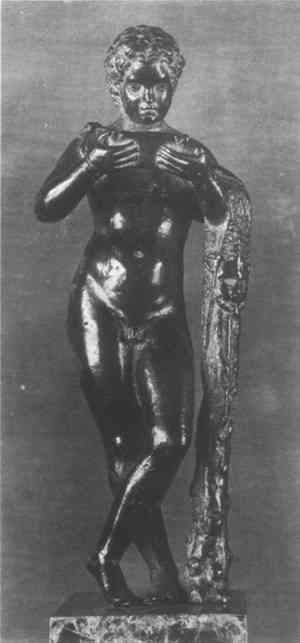ON COPYING BRONZE STATUETTES
Ann H. Allison, & Robert B. Pond
4 THE YOUNG HERCULES BY ANTICO
THREE STATUETTES of Antico's motif of Young Hercules are extant. The Young Hercules in the J. N. Jantzen collection (Fig. 6) in Bremen displays the virtuoso modeling and technique found in the best bronzes by this artist and, correspondingly, can be assumed to be autograph. The body forms of this statuette are plastic, generalized, and chased and polished until smoothly sensuous. Concern with texture is evident. Characteristic meticulously executed details include the ringlets of the hair, the small mouth, and the tiny nails on the hands and feet. Two other examples of lesser quality are in the Louvre (Figs. 7, 8). One of the Louvre bronzes differs significantly in internal measurements from the other and from the Jantzen bronze. Here the larger Louvre figure shall be referred to as Louvre A and the smaller as Louvre B.
Fig. 6.
Young Hercules, J. N. Jantzen Collection, Bremen.
 |
Fig. 7.
Young Hercules, Mus�e du Louvre, Paris (Louvre A).
 |
Fig. 8.
Young Hercules, Mus�e du Louvre, Paris (Louvre B).
 |
The application of the IM method which produced Tables II to IV has been discussed. The statistical data shows that the majority of measurements of the Jantzen bronze and Louvre A are either equal or differ by only 1.25%. Comparison of the individual stations shows that width and depth measurements of the body are either equal or differ by 2.5%, and that measurements of length and of the head deviate 1.25% to 3.75% and, in one case, 8.75%. The sum of the data indicates that Louvre A is from the same model or mold as the Jantzen bronze. Louvre B is 7.5% removed from the Jantzen bronze for the majority of the measurements, but the relative size index is 5% in the pair comparison with Louvre A. The smaller deviation from Louvre A is to be expected, for Louvre A is not so large as the Jantzen bronze at a majority of stations.
The alloys of all figures appear to be reddish. Applying the 2.5% shrinkage for red-pink alloys, it is established that Louvre B is approximately twice removed from both the Jantzen bronze and Louvre A. As both the Jantzen figure and Louvre A originate from the same model or mold, these are considered to originate in Antico's workshop. Similar to the autograph Jantzen Young Hercules, Louvre A has relatively slender core pins which are usually characteristic of Antico's casting procedure, but, as the rendering of its details is harder and the technique not virtuoso, it is presumably produced by a shop member. Louvre B is by another artist and produced at a later date, as time must be allowed for a cast twice removed from the first edition. Its artist used larger corepins and a core support at the crown of the head. All details of this statuette are softer and some differ from those of the two other specimens. Its once black patina, which has gritty material in the crevices, suggests that it was intended to pass as an antique bronze. The ultimate model of this bronze could be the Jantzen figure as that bronze has had a part-mold made of it. Incisions where one would expect divisions of a part-mold to be found may be seen cut through the patina of this bronze into the raw metal.
|


